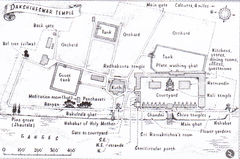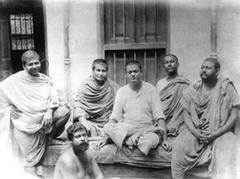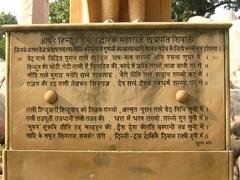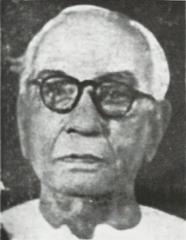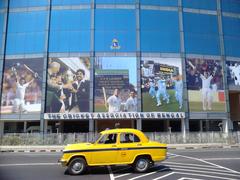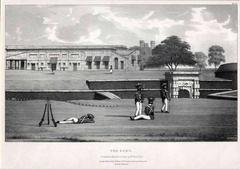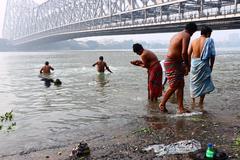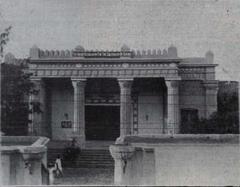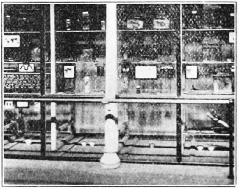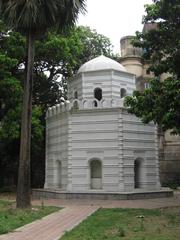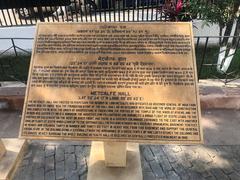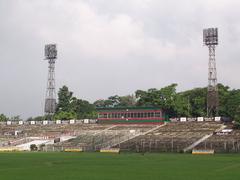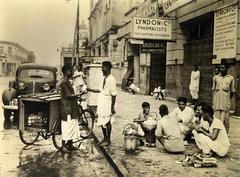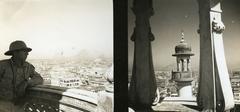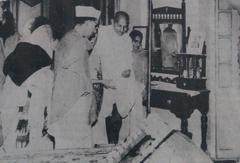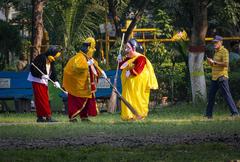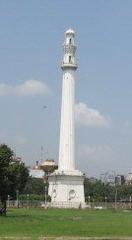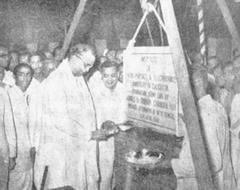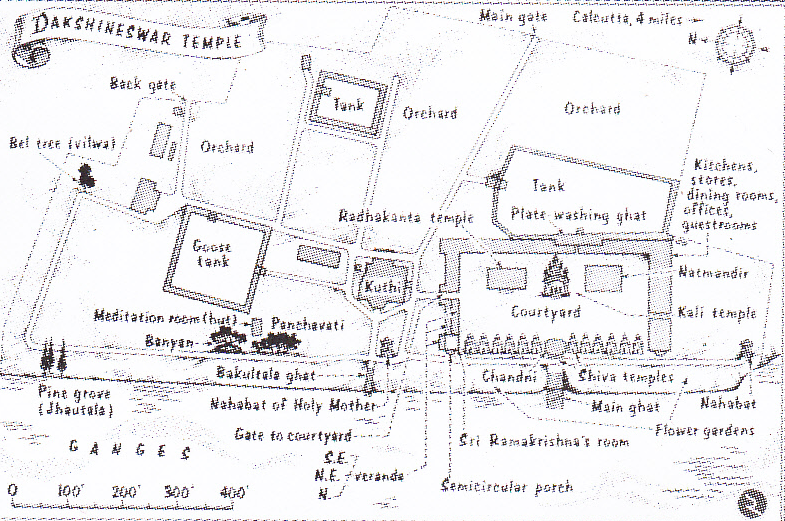
Visiting Dakshineswar Kali Temple: Hours, Tickets, and Tips
Date: 16/07/2024
Introduction
The Dakshineswar Kali Temple, a monumental structure located on the eastern bank of the Hooghly River in Kolkata, India, stands as an epitome of spiritual, cultural, and architectural grandeur. Founded by Rani Rashmoni in 1855, this temple is dedicated to Bhavatarini, an aspect of the goddess Kali, and has become an indispensable part of Bengal’s religious and cultural landscape. The temple’s significance is not limited to its religious aspects but extends to its historical, social, and architectural relevance, attracting millions of devotees and tourists annually (source).
The temple’s rich history is intertwined with the life and teachings of Sri Ramakrishna Paramahamsa, who served as the head priest from 1856 to 1886. His profound spiritual experiences and teachings drew numerous followers, including Swami Vivekananda, and transformed the temple into a focal point for the Bengal Renaissance and the spread of Vedanta philosophy (source).
Architecturally, the temple is a marvel of traditional Bengali style, featuring a nine-spired (Nava-ratna) structure and intricate terracotta designs. The temple complex, spread over 25 acres, includes twelve smaller Shiva temples, a Radha-Krishna temple, a large courtyard, and a bathing ghat on the Hooghly River, making it a serene and picturesque location (source).
This comprehensive guide aims to provide visitors with detailed information on the temple’s history, significance, visitor information, travel tips, nearby attractions, and accessibility features. Whether you are a devotee seeking spiritual solace or a tourist eager to explore Kolkata’s cultural heritage, the Dakshineswar Kali Temple offers an enriching experience that is both spiritually fulfilling and culturally enlightening.
Table of Contents
- Introduction
- History of Dakshineswar Kali Temple
- Visitor Information
- Nearby Attractions
- Accessibility
- Special Events and Guided Tours
- Preservation and Modernization Efforts
- FAQ
- Conclusion
History of Dakshineswar Kali Temple
Foundation and Construction
The Dakshineswar Kali Temple was founded by Rani Rashmoni, a philanthropist and a devotee of the goddess Kali. The temple’s construction began in 1847 and was completed in 1855. Rani Rashmoni, who belonged to a wealthy zamindar family, had a divine vision instructing her to build a temple dedicated to Kali. She purchased a 20-acre plot in the village of Dakshineswar and invested a significant portion of her wealth into the construction of the temple complex (source).
Architectural Design
The temple’s architecture is a fine example of the traditional Bengali style, featuring a nine-spired (Nava-ratna) structure. The main temple, which houses the idol of Bhavatarini, a form of Kali, stands at a height of 100 feet. The temple complex also includes twelve smaller temples dedicated to Lord Shiva, arranged in a row along the riverbank, and a temple dedicated to Radha-Krishna (source).
Inauguration and Early Years
The temple was consecrated on May 31, 1855, with a grand ceremony attended by thousands of devotees. The idol of Kali was installed in the sanctum sanctorum, and the temple quickly became a major pilgrimage site. Rani Rashmoni appointed Ramkumar Chattopadhyay, a renowned scholar and priest, as the head priest. After Ramkumar’s death, his younger brother, Gadadhar Chattopadhyay, who later became known as Sri Ramakrishna Paramahamsa, took over the priestly duties (source).
Sri Ramakrishna’s Association
Sri Ramakrishna’s association with the Dakshineswar Kali Temple is one of the most significant aspects of its history. He served as the head priest from 1856 to 1886 and had numerous spiritual experiences and visions during his tenure. His teachings and spiritual practices attracted a large number of followers, including notable figures like Swami Vivekananda (source).
Historical Events and Developments
Over the years, the Dakshineswar Kali Temple has witnessed several historical events and developments. During the Indian independence movement, the temple served as a meeting place for freedom fighters and social reformers. The temple complex has also undergone several renovations and expansions to accommodate the growing number of devotees (source).
Visitor Information
Visiting Hours and Tickets
The Dakshineswar Kali Temple is open to visitors from 6:00 AM to 12:30 PM and from 3:00 PM to 9:00 PM. There is no entry fee, but donations are welcome. Special arrangements are made during festivals, and it is advisable to check the official website for any changes in visiting hours or ticket information (source).
Travel Tips
Best Time to Visit
The best time to visit Dakshineswar Kali Temple is during the winter months (November to February) when the weather is pleasant. Avoid visiting during peak summer and monsoon seasons due to extreme heat and heavy rainfall.
How to Reach
The temple is well-connected by road, rail, and river. You can reach Dakshineswar by local trains from Sealdah Station or by taking a ferry from various ghats along the Hooghly River. Public buses and taxis are also available from different parts of Kolkata.
Nearby Attractions
- Belur Math - The headquarters of the Ramakrishna Mission, located just across the river from Dakshineswar.
- Howrah Bridge - An iconic symbol of Kolkata, offering a scenic view of the Hooghly River.
- Vivekananda Setu - Also known as Bally Bridge, it connects Dakshineswar to Belur Math.
Accessibility
The Dakshineswar Kali Temple is equipped with ramps and wheelchair-accessible paths to accommodate differently-abled visitors. Restrooms and drinking water facilities are available within the temple complex.
Special Events and Guided Tours
The temple hosts several annual festivals, including Kali Puja and Durga Puja, attracting thousands of devotees. Guided tours are available, providing insights into the temple’s history and significance. Photography is allowed in designated areas, making it a great spot for capturing memorable moments.
Preservation and Modernization Efforts
In recent years, the Dakshineswar Kali Temple has seen significant efforts towards preservation and modernization. The temple authorities have implemented various measures to maintain the structural integrity of the temple and its surroundings. This includes regular maintenance work, the use of advanced preservation techniques, and the installation of modern facilities for the convenience of visitors. Additionally, the temple has embraced digital technology, offering virtual tours and online services to cater to the needs of devotees worldwide (source).
FAQ
What are the visiting hours for Dakshineswar Kali Temple?
The temple is open from 6:00 AM to 12:30 PM and from 3:00 PM to 9:00 PM.
How much are the tickets for Dakshineswar Kali Temple?
There is no entry fee, but donations are welcome.
What are the nearby attractions to Dakshineswar Kali Temple?
Nearby attractions include Belur Math, Howrah Bridge, and Vivekananda Setu.
Conclusion
The Dakshineswar Kali Temple’s history and significance make it a must-visit destination in Kolkata. Whether you are a devotee or a tourist, the temple offers a unique blend of spiritual and cultural experiences. Plan your visit, explore the nearby attractions, and immerse yourself in the rich heritage of Bengal. For more updates, follow us on social media and stay connected.
References
- Dakshineswar Kali Temple. West Bengal Tourism. Retrieved from https://www.wbtourismgov.in/destination/place/dakshineswar_kali_temple
- Ramakrishna. (n.d.). In Encyclopædia Britannica. Retrieved from https://www.britannica.com/biography/Ramakrishna
- Dakshineswar Kali Temple History. Retrieved from https://www.dakshineswarkalitemple.org/history
- Dakshineswar Temple Gets a Makeover. (n.d.). The Telegraph. Retrieved from https://www.telegraphindia.com/west-bengal/dakshineswar-temple-gets-a-makeover/cid/1505980
- Dakshineswar Kali Temple Modernization. Retrieved from https://www.dakshineswarkalitemple.org/modernization
